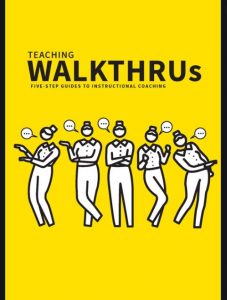Year 9 Future Ready Programme Launches
In February, five Aspirations Academies were involved in the Year 9 Future Ready Programme, delivered by Speakers...
Read more Year 9 Future Ready Programme LaunchesThis article was originally published in Schools Week and is a book review by Diana Detterick, Associate Assistant Principal, Atlantic Academy, of Teaching WalkThrus: Five-Step Guides to Instructional Coaching by Tom Sherrington and Oliver Caviglioli.
Cognitive Load Theory. Dual Code Theory. Rosenshine’s Principles of Instruction.
How do I connect all of these concepts, and many others, to use in my classroom?
If you have ever pondered the same question, Teaching WalkThrus is the solution. Subtitled Five-step guides to instructional coaching, this practical, informative and insightful book provides 50 effective, research-informed techniques.
With 19 years of teaching, and leadership experience in primary and secondary schools, I can confidently recommend this book to all teachers, regardless of their experience.
Teaching WalkThrus is structured into three parts: ‘Why’, ‘What’ and ‘How’. I’m a practical person, and I must admit that normally I would skip straight to the ‘what’ chapter. However, reading
the ‘why’ section first is essential as it provides an overview of the key research and education ideas that form the basis for the book.
Additionally, there is an engaging explanation of the rationale for the use and design of Oliver Caviglioli’s visual instructions. This section was beneficial as a quick primer and reminder of Rosenshine’s Principles Of Instruction, Daniel Willingham’s Why Don’t Students Like School? and Ron Berger’s An Ethic of Excellence.

The ‘what’ part of Teaching WalkThrus is divided into six sections, each containing a “core selection of ideas to provide good coverage of common issues and practices”. Each idea, or WalkThru, is on two pages and contains a short overview paragraph accompanied by five concise and precisely illustrated steps.
There is no need to read the six sections in order, and various sections will apply to different audiences and purposes, but there are few professional development situations that Sherrington and Caviglioli haven’t covered here.
New to teaching, need to refresh your behaviour management or need advice on how to lead others in improving teacher and student relationships? The first section, ‘Behaviour & Relationships’, is the place to start. In the middle of a curriculum review or in the planning stages of a new unit of work? Consider the key ideas in the second section entitled ‘Curriculum Planning’.
Looking to improve your use of explanation and modelling? Read the third section.
Leading your team or school on improving feedback? The fourth section, ‘Questioning & Feedback’, provides nine key ideas such as metacognitive talk and deliberate vocabulary development.
The fifth, ‘Practice & Retrieval’, contains strategies for improving students’ “confidence and fluency with a wide range of knowledge and physical skills”. And if you’re thinking of using collaborative work or wanting to enhance oracy activities within lessons, then the final section entitled ‘Mode B Teaching’ (based on Sherrington’s previous The Learning Rainforest) includes ideas on enquiry projects and open-response tasks.
Finally, leaders with responsibility for CPD in their schools will find the ‘how’ part of the
book invaluable. It covers strategic methods to “engineer professional learning processes”
so that they are “effective and sustained”. The first WalkThru of this section explains the ADAPT approach (Attempt, Develop, Adapt, Practise, Test), Sherrington and Caviglioli’s recommended method for implementing WalkThrus.

The remaining key ideas in the ‘how’ section focus on how to use WalkThrus in observations, instructional coaching, as part of a CPD cycle and in order to solve
learning problems.
I have two quibbles with the book but neither is worth demoting it from a solid five-star rating. The subtitle, Five-step guides to instructional coaching doesn’t quite capture its full breadth and scope for teachers generally. More importantly, perhaps, while colleagues who teach younger children will benefit from the vast majority of the WalkThrus, I struggled to find specific examples that primary teachers would directly identify with. That seems an unfortunate oversight and an easy bias to have remedied.
Still, in spite of that, Teaching WalkThrus has easily become my go-to reference from the many educational titles lining my bookshelves, and I have no doubt it will be for any who read it.
In February, five Aspirations Academies were involved in the Year 9 Future Ready Programme, delivered by Speakers...
Read more Year 9 Future Ready Programme LaunchesThe first Aspirations Employability Diploma final of 2025 marked a significant milestone in the academic year, bringing...
Read more AAT Celebrates First Aspirations Employability Diploma Final of 2025The Diversity and Inclusion in STEM report acknowledges the lifelong benefits of STEM-related skills. It notes that opportunities...
Read more Dr Jeffery Quaye OBE: The next government must shift our anti-maths culture